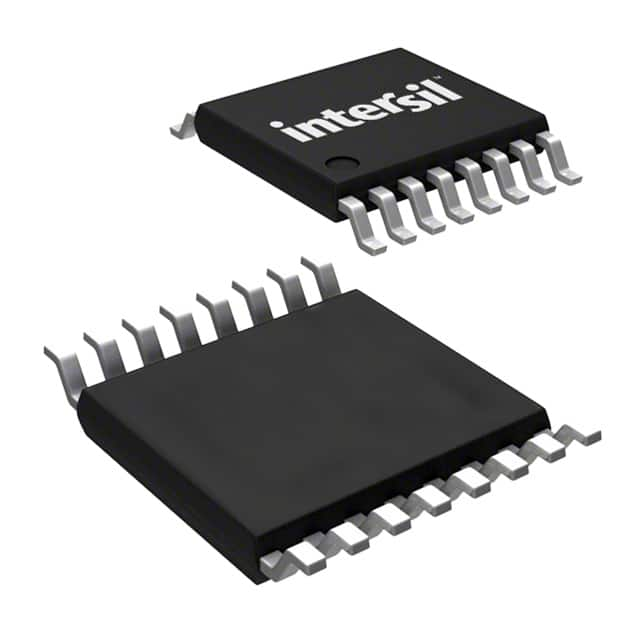Consulte las especificaciones para obtener detalles del producto.

X9420WS16ZT1
Product Overview
- Category: Integrated Circuit (IC)
- Use: Digital Potentiometer
- Characteristics: Programmable, Non-volatile, 16-bit resolution
- Package: Surface Mount Technology (SMT)
- Essence: Provides digital control of resistance in electronic circuits
- Packaging/Quantity: Tape and Reel, 250 units per reel
Specifications
- Resolution: 16 bits
- Resistance Range: 0 to 100 kilohms
- Supply Voltage: 2.7V to 5.5V
- Operating Temperature: -40°C to +85°C
- Interface: Serial Peripheral Interface (SPI)
- Non-volatile Memory: Stores wiper position during power-off
Detailed Pin Configuration
The X9420WS16ZT1 IC has the following pin configuration:
- VCC: Supply voltage input
- GND: Ground reference
- CS: Chip select for SPI communication
- SCK: Serial clock input for SPI communication
- SI: Serial data input for SPI communication
- SO: Serial data output for SPI communication
- WP: Write protect input for non-volatile memory
- H0-H15: Analog wiper terminal
Functional Features
- Programmable resistance allows precise control over circuit parameters
- Non-volatile memory retains wiper position even when power is off
- SPI interface enables easy integration with microcontrollers
- Wide operating temperature range for various environments
- High resolution provides fine adjustment capabilities
Advantages and Disadvantages
Advantages: - Precise and accurate resistance control - Non-volatile memory ensures settings are retained - Easy integration with microcontrollers - Wide operating temperature range for versatility - High resolution allows fine adjustments
Disadvantages: - Limited resistance range (0 to 100 kilohms) - Requires SPI interface for communication
Working Principles
The X9420WS16ZT1 is a digital potentiometer that utilizes a series of resistive elements and switches controlled by an internal digital-to-analog converter (DAC). The resistance value can be programmed digitally through the SPI interface, allowing precise control over circuit parameters. The non-volatile memory ensures that the wiper position is retained even when power is off.
Detailed Application Field Plans
The X9420WS16ZT1 finds applications in various fields, including:
- Audio Equipment: Precise volume control in amplifiers and audio mixers
- Industrial Automation: Fine adjustment of process control parameters
- Test and Measurement: Calibration and signal conditioning circuits
- Communication Systems: Gain control in transmitters and receivers
- Automotive Electronics: Control of lighting intensity and motor speed
Detailed and Complete Alternative Models
- X9420WS16ZT2: Similar specifications with extended resistance range (0 to 1 megohm)
- X9420WS32ZT1: Higher resolution (32 bits) for ultra-fine adjustments
- X9420WS16ZT1A: Enhanced ESD protection for rugged environments
(Note: This list is not exhaustive and may vary based on availability and specific requirements.)
This entry provides an overview of the X9420WS16ZT1 digital potentiometer, including its basic information, specifications, pin configuration, functional features, advantages and disadvantages, working principles, application field plans, and alternative models. It serves as a comprehensive reference for understanding and utilizing this product effectively.
Enumere 10 preguntas y respuestas comunes relacionadas con la aplicación de X9420WS16ZT1 en soluciones técnicas
Sure! Here are 10 common questions and answers related to the application of X9420WS16ZT1 in technical solutions:
Q1: What is X9420WS16ZT1? A1: X9420WS16ZT1 is a specific model of digital potentiometer manufactured by a particular company. It is commonly used in various technical solutions.
Q2: What is the purpose of X9420WS16ZT1 in technical solutions? A2: The purpose of X9420WS16ZT1 is to provide variable resistance or impedance control in electronic circuits, allowing for precise adjustment of parameters such as volume, brightness, or gain.
Q3: How does X9420WS16ZT1 work? A3: X9420WS16ZT1 works by digitally controlling the resistance value using integrated circuitry. It can be programmed to adjust the resistance through digital signals, providing flexibility and accuracy.
Q4: What are the key features of X9420WS16ZT1? A4: Some key features of X9420WS16ZT1 include non-volatile memory, low power consumption, wide operating voltage range, and compatibility with various communication protocols.
Q5: In which technical applications can X9420WS16ZT1 be used? A5: X9420WS16ZT1 can be used in a wide range of technical applications, including audio systems, lighting controls, motor control, instrumentation, and many other electronic devices that require adjustable resistance.
Q6: Can X9420WS16ZT1 be used in both analog and digital circuits? A6: Yes, X9420WS16ZT1 can be used in both analog and digital circuits. It provides a digital interface for control while functioning as an analog component within the circuit.
Q7: What is the resolution of X9420WS16ZT1? A7: The resolution of X9420WS16ZT1 refers to the number of distinct resistance values it can provide. It typically has a high resolution, allowing for precise adjustments.
Q8: Is X9420WS16ZT1 compatible with microcontrollers or other digital control systems? A8: Yes, X9420WS16ZT1 is designed to be compatible with various digital control systems, including microcontrollers. It can be easily integrated into such systems for remote or automated control.
Q9: Can X9420WS16ZT1 replace traditional mechanical potentiometers? A9: Yes, X9420WS16ZT1 can be used as a replacement for traditional mechanical potentiometers in many applications. It offers advantages such as smaller size, higher reliability, and digital control capabilities.
Q10: Are there any limitations or considerations when using X9420WS16ZT1? A10: Some considerations include ensuring proper voltage levels, understanding the communication protocol requirements, and taking precautions to prevent electrostatic discharge (ESD) during handling and installation.
Please note that the specific details and answers may vary depending on the manufacturer's specifications and application requirements.

